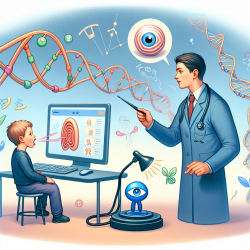Introduction
The recent study titled "Novel Genetic and Biochemical Insights into the Spectrum of NEFL-Associated Phenotypes" provides groundbreaking insights into the genetic underpinnings of NEFL-associated phenotypes, particularly in the context of Charcot-Marie-Tooth (CMT) disease. This research is pivotal for practitioners in speech-language pathology, especially those focused on pediatric outcomes, as it opens up new avenues for understanding the genetic factors that may influence speech and motor development in children.
Understanding NEFL and Its Implications
NEFL encodes the neurofilament light chain protein, a critical component in maintaining neuronal stability and function. Pathogenic variants in NEFL are linked to various forms of CMT, a group of inherited disorders affecting the peripheral nerves. The study by Della Marina et al. expands the current knowledge on NEFL-related neurological diseases by exploring the genetic landscape and clinical presentations of these disorders.
The research highlights the importance of NEFL in both the central and peripheral nervous systems. Dysfunctional NEFL can lead to toxic neurofilament accumulation, a hallmark of many neurodegenerative disorders, including CMT, amyotrophic lateral sclerosis (ALS), and others. For speech-language pathologists, understanding these genetic factors is crucial as they may impact speech and language development in affected children.
Key Findings and Their Application
The study identifies several key findings that can be directly applied to improve pediatric therapy outcomes:
- Genetic Variability: The research identifies 34 different CMT-causing pathogenic variants in NEFL. This genetic variability can lead to a wide range of clinical manifestations, emphasizing the need for personalized therapy approaches.
- Muscular Involvement: The study reports muscular involvement in CMT2E patients, which is crucial for practitioners to consider when designing therapy plans that address both speech and motor development.
- Proteomic Profiling: Findings from skeletal muscle proteomics indicate the affection of cytoskeletal proteins, providing insights into the molecular processes that could be targeted in therapeutic interventions.
Encouraging Further Research
For practitioners, this study serves as a call to integrate genetic insights into clinical practice. It encourages further research into how NEFL variants affect speech and motor development. By understanding the genetic basis of these disorders, practitioners can develop more effective, individualized therapy plans that cater to the specific needs of each child.
Conclusion
The insights provided by the study "Novel Genetic and Biochemical Insights into the Spectrum of NEFL-Associated Phenotypes" are invaluable for enhancing pediatric speech therapy outcomes. By leveraging these findings, practitioners can improve their skills and develop more effective therapy plans. For those interested in delving deeper into the research, the original paper can be accessed here.










